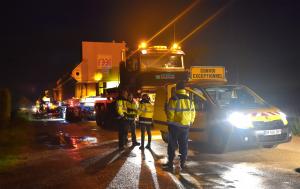Travelling light
Components for the ITER machine and plant systems come in all shapes, sizes and weights. For transportation purposes, the largest and heaviest fall into two categories: the Highly Exceptional Loads (HEL) and the Conventional Exceptional Loads (CEL). Any load heavier than 60 tonnes, or with dimensions in excess of 5 metres in height and/or 5 metres in width, is considered an HEL.
Transporting an HEL from its unloading point at Fos-sur-Mer harbour to the ITER site is a massive and costly logistics operation.
Once loaded onto a trailer, the HEL must be transferred to a specially-designed barge and ferried across the inland sea Etang-de-Berre. From then on, the land journey along the 104-kilometre ITER Itinerary must be performed at night—roads must be closed to traffic and reopened after the convoy's passage, up to 260 kilometres of detours must be organized, and two different thruways (which the convoy crosses in four different locations) must be closed for the better part of the night.
In addition, several dozen "escort and assistance" technicians—along with gendarmerie forces—need to be mobilized.
CEL, on the other hand, travel by day on regular roads directly from Fos harbour and completely avoid crossing the Etang-de-Berre. They also do not require roadway closings and demand only limited technical assistance, plus two gendarmerie motorcyclists to regulate traffic.
The difference in cost is considerable.
"One of the specifications of our logistics service provider framework contract is to always seek best value for money," explains François Genevey, the ITER project director at DAHER. "Reducing transportation costs is also a strong preoccupation for Europe, which pays for the last leg of the operation—once a load has reached French territory."
The six lower cylinder sectors of the cryostat, part of India's procurement responsibilities for ITER, were initially classified as HEL. But as their height only exceeded the CEL definition by 65 centimetres it was worth trying to downgrade them.
The key to moving a load from one category to the other is engineering. Before the first "HEL-into-CEL" convoy could hit the road, DAHER, the Indian Domestic Agency and cryostat manufacturer Larsen & Toubro Ltd. worked for several months to choose an adapted itinerary, find a suitable trailer and design a reinforced frame to secure the component.
"In order to avoid obstacles such as bridges or overpasses, we needed a trailer that could be lowered to within 12 centimetres of the road's surface. There is only one trailer in France that offers this possibility ─ a 'hydraulic bridge trailer' whose bed we adapted to meet our requirements."
On 27 February the first "HEL-into-CEL" convoy left Fos harbour and arrived at the ITER site two days later. Five subsequent convoys were organized for the remaining cryostat segments, all of them safely delivered on schedule.
For DAHER and the European Domestic Agency the objective has been attained: the cost for six CEL convoys proved to be 60 percent lower than the two HEL convoys originally planned (which would have transported three segments each).
Ben Slee, the Technical Responsible Officer for ITER component transportation at the European Domestic Agency, is satisfied with the result. "Reduction of project cost and risk is one of Europe's most important objectives. Avoiding the expensive crossing of Etang-de-Berre also means less handling of the component, and thus less risk of eventual damage. Having an incentive clause in our contract with Daher, by which Daher receives part of the money saved, contributes to a very pro-active approach and encourages all parties to look for cost savings."



